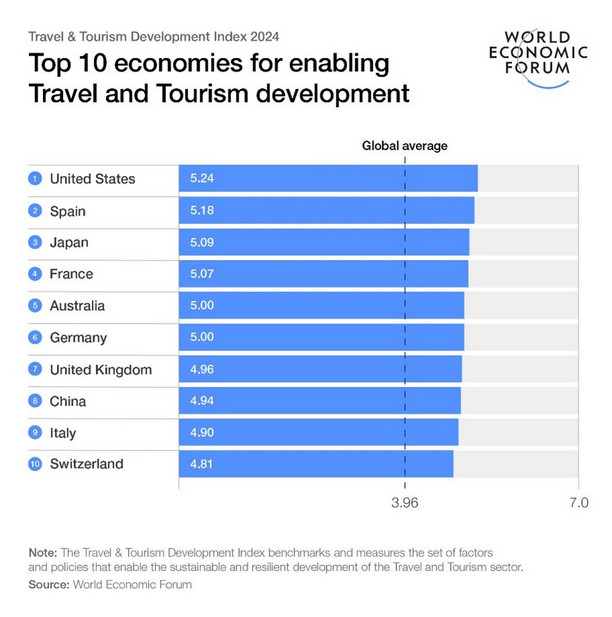May 24, 2024
QUEZON CITY – Global tourism is on a rebound post-pandemic. International tourist arrivals, and with it the travel and tourism sector’s contribution to global GDP, are foreseen to return to pre-pandemic levels this year, fueled by the lifting of Covid-19-related restrictions and strong “pent-up demand,” as per the new World Economic Forum (WEF) travel and tourism study, released last May 21.
High-income economies in Europe and Asia-Pacific continue to top the WEF Travel and Tourism Index, with the United States, Spain and Japan leading the rankings anew, as per the WEF report.
Meanwhile, the Middle East had the highest recovery rates in international tourist arrivals at 20% above the 2019 level. Europe, Africa, and the Americas likewise showed a strong recovery of about 90% last year.
These are among the most significant findings of the Travel & Tourism Development Index 2024 (TTDI), a biennial report published in collaboration with the University of Surrey, which analyses the travel and tourism sectors of 119 countries around a range of factors and policies.
2024 highlights
Out of the top 30 index scorers in 2024, 26 are considered high-income economies, with 19 based in Europe, seven in Asia-Pacific, three in the Americas, and one (the United Arab Emirates) in the Middle East and North Africa region (MENA). The top 10 countries in the 2024 edition include the United States, Spain, Japan, France, Australia, Germany, the United Kingdom, China, Italy, and Switzerland.

Source: World Economic Forum
The report ranks Japan as the top performer in the APAC region. China has the region’s largest and the world’s second-largest T&T economy, while India (39th) has the largest T&T sector in South Asia.
Meanwhile, the Philippines (69th) has relied the most on T&T for its GDP in 2022 and Singapore (13th) is the top performer in South-East Asia.
The results underscore how high-income economies continue to enjoy more favourable conditions for travel, thanks to friendly business environments, dynamic labour markets, open travel policies, established transport and tourism infrastructure, and well-developed natural, cultural, and non-leisure attractions.
Developing countries, however, have seen some of the greatest improvements in recent years. Among the upper-middle-income economies, while China remains in the top 10, emerging travel and tourism destinations such as Indonesia, Brazil, and Türkiye have joined in the top quartile of the rankings.
Indonesia, specifically, has become more competitive as the country emerged as the most improved on the list, according to an article on The Jakarta Post. The report released on Tuesday ranks Indonesia 22nd globally, up 14 spots since the last ranking from 2019, marking the biggest leap in Southeast Asia.
Low- to upper-middle-income economies, meanwhile, account for over 70% of countries that have seen an improvement in their scores since 2019, while MENA and sub-Saharan Africa are among the most improved regions. Interestingly, Saudi Arabia and the UAE are the only high-income economies to clinch a spot among the top 10 most improved economies between 2019 and 2024.
Despite these improvements, the TTDI emphasizes that “significant investment is needed to close gaps in enabling conditions and market share between developing and high-income countries.”
One way to achieve this would be to sustainably leverage natural and cultural assets, “which are less correlated with country income level than other factors, and can offer developing economies an opportunity for tourism-led economic development,” notes the report.
“It’s essential to bridge the divide between differing economies’ ability to build a strong environment for their travel and tourism sector to thrive,” says Iis Tussyadiah, professor and head of the School of Hospitality and Tourism Management at the University of Surrey.
“The sector has big potential to foster prosperity and mitigate global risks, but that potential can only be fully realized through a strategic and inclusive approach.”
A “turning point”

Representational photo of Bali. Indonesia has become more competitive as the country emerged as the most improved country on the list, according to an article on The Jakarta Post. The report released on Tuesday ranks Indonesia 22nd globally, up 14 spots since the last ranking from 2019. PHOTO: UNSPLASH
This year marks a “turning point” for the travel and tourism sector, according to Francisco Betti, head of the Global Industries team at the WEF. He adds that the sector has the capacity to drive growth and uplift communities through economic and social transformation.
“The TTDI offers a forward-looking window into the current and future state of travel and tourism for leaders to navigate the latest trends in this complex sector and sustainably unlock its potential for communities and countries across the world,” he explains.
The global tourism industry is expected to recover from the lows of the Covid-19 pandemic and surpass the levels seen before the global health emergency, according to the WEF.
This outlook is due to a “significant increase” in demand worldwide. “More available flights, better international openness, and increased interest and investment in natural and cultural attractions” has further helped boost the sector.
Post-pandemic rebound but a “mixed” recovery

Representational photo of the Great Wall of China. The global tourism industry is expected to recover from the lows of the Covid-19 pandemic and surpass the levels seen before the global health emergency, according to the WEF. PHOTO: UNSPLASH
Despite a more robust travel landscape, the recovery of the global tourism sector has been “mixed,” the report stated. While 71 of the 119 economies in the rankings have increased their scores since 2019, the average index score is just a marginal 0.7% above pre-pandemic levels.
The sector continues to be faced with other external challenges: growing macroeconomic, geopolitical, and environmental risks; increased scrutiny of tourism’s sustainability practices; and the impact of new digital technologies (i.e., big data and artificial intelligence).
On top of these are shortages in labour, air route capacity, capital investment, productivity, and other sector supply factors, causing an inability to keep up with surging demand. “This imbalance, worsened by global inflation, has increased prices and service issues,” according to WEF.


